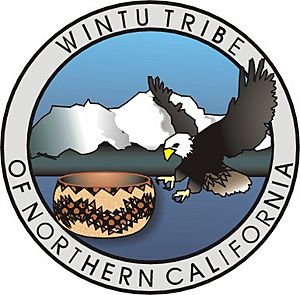Wintu facts for kids

Seal
|
|
| Total population | |
|---|---|
| 2,500 (three major groups) | |
| Regions with significant populations | |
| Languages | |
| English, formerly Wintu | |
| Religion | |
| Christianity, Native religion | |
| Related ethnic groups | |
| Wintun (Nomlaki and Patwin), Yokuts |
The Wintu are a group of Native American people. They live in what is now Northern California. They are part of a larger group called the Wintun people. Other groups in the Wintun family include the Nomlaki and the Patwin. The Wintu people speak the Wintu language, which is part of the Penutian language family.
Long ago, the Wintu lived mostly on the western side of the northern Sacramento Valley. Their land stretched from the Sacramento River to the Coast Range. Their territory also included parts of the southern McCloud River and the upper Trinity River. They also lived near what is now Chico. Today, most Wintu people live on special lands called reservations and rancherias. These are in counties like Colusa, Glenn, Yolo, Mendocino, and Shasta.
Contents
Wintu History and Changes
The Wintu people first met Euro-Americans in 1826. This was during an expedition led by Jedediah Smith. Another expedition followed in 1827, led by Peter Skene Ogden.
Between 1830 and 1833, many Wintu people became sick and died. A serious malaria epidemic spread through the area. It is thought that about 75% of the Native people in the Sacramento Valley died during this time.
Life Changes for the Wintu
After the epidemic, the Wintu people were weaker. More European-American settlers began to arrive. These settlers brought their sheep and cattle, which ate the plants the Wintu used for food. Gold mining also started, and the mining activities polluted the rivers. This made it harder for the Wintu to find food and clean water. Some Wintu people were also forced to work in the gold mines.
In 1846, a group led by John C. Frémont and Kit Carson attacked Wintu and Yana people. About 175 Native people were killed. Settlers tried to take over Wintu land and force them to move. In 1850, at a gathering meant to be friendly, settlers gave poisoned food to local Native people. About 145 Wintu people, including those from the Nomsuu and Wenemem Wintu groups, died. More Wintu people died and their lands were harmed in 1851 and 1852. One sad event was the Bridge Gulch Massacre.
Wintu Culture and Traditions
The Wintu people speak the Wintu language, which is one of the Wintuan languages.
Stories and legends are an important part of Wintu culture. Grant Towendolly, a Trinity River Wintu elder, shared many of these stories with Marcelle Masson. These stories were later published in a book called A Bag of Bones in 1966. These tales help us understand the beliefs and history of the Wintu people.
Wintu Population Over Time
Historians have different ideas about how many Wintu people lived before Europeans arrived.
- Alfred L. Kroeber thought that in 1770, there were about 12,000 Wintu, Nomlaki, and Patwin people combined.
- Sherburne F. Cook first estimated about 2,950 Wintu people. Later, he changed his estimate to about 5,300.
- Frank R. LaPena estimated a total of 14,250 Wintun people in the 1970s.
By 1910, Kroeber estimated that the combined population of Wintu, Nomlaki, and Patwin was only about 1,000 people.
Today, the Wintu population has grown again. There are now about 2,500 Wintun people. Many of them live on reservations and rancherias. These include the Round Valley Reservation, and the Colusa, Cortina, Grindstone Creek, Redding, and Rumsey rancherias.

